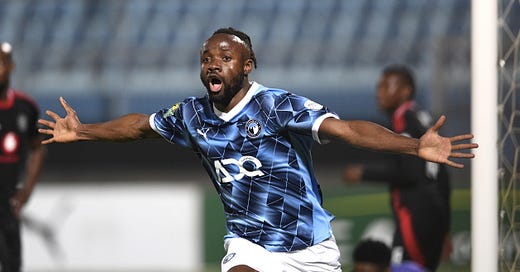CAF Champions League final: the billionaire’s club
Mamelodi Sundowns and Pyramids face off in the first African Champions League final built off the back of billionaire owners.
The CAF Champions League final kicks off on Saturday at 1PM GMT in Pretoria when Mamelodi Sundowns take on Pyramids of Cairo in the first leg of the final.
It’s also the first ever Champions League final to be played between clubs owned by billionaires and potentially is ushering a new age of African football, one trying to find its place in a wider world of football in which the super rich are now active participants.
With the new moneyed Club World Cup launching this summer, the CAF Champions League final is now a game worth more than prestige and glory, a game worth millions and a chance to enter the world stage, perhaps it’s only fitting that the first final that would qualify teams for the next Club World Cup is contested by Africa’s two richest clubs.
I say two richest clubs, that title belongs firmly to Al Ahly, in terms of revenue and size of club, but with no spending limits on the African continent, it’s actually the two clubs owned by the richest owners that have the spending power.
The Brazilians backed by mining billions
On the one side is Mamelodi Sundowns. A club founded as early as 1964 in Pretoria as Marabastad Sundowns. With roots going back into the 1940s, the club was fairly successful but nowhere near the size of their rivals in Soweto, Kaizer Chiefs and Orlando Pirates.
After three back-to-back titles at the turn of the millennia and Champions League final loss to Al Ahly, the club would backslide, finishing as low as 10th in 2004.
It was that same year when a certain Patrice Motsepe would buy the club, transforming it, South African and ultimately football on the continent forever.
Over the next seven years Sundowns would win a couple of PSL titles but more importantly could begin financially outperforming their domestic rivals and begin bringing in the top talent in South Africa as well as global stars like Hristo Stoichkov and Johan Neeskens who both had spells in charge of the club.
The club would really kick on though, when Pitso Mosimane took charge in 2012. The club went from competitive to dominant. In his seven year spell, Mosimane would win four league titles, three domestic cups and the club’s maiden Champions League title in 2016.
And Sundowns have never looked back, ushering in an era of dominance in South African football that has never been seen before. Last week they wrapped up an eighth successive PSL title and are the most in form African team heading into the Club World cup next month.
As Patrice Motsepe officially left the club to become the president of CAF, his son Tholipe (with no interference from his father, we are regularly assured) has continued the investment in the club that dwarfs every other in Sub-Saharan Africa.
Sundowns now are not only recruiting the best players from all their rivals in South Africa, but are regularly raiding South American clubs for top talents like Marcelo Allende, Lucas Ribeiro and Arthur Sales.
Their success has undoubtedly ushered in a new era of South African success on the continent. After failing to qualify for the 2021 AFCON in Cameroon, the national team, built of a Sundowns core, reached the semi finals of the tournament for the first time in over two decades. The U-20 team just two weeks ago won their first ever AFCON. In the women’s side of the game, Sundowns have won two of four Champions League titles and a similarly Sundowns bolstered national women’s team won their first ever WAFCON in 2022.
But closer to home there are more concerns than celebrations. The PSL was once one of the most competitive leagues in Africa but whereas in the eight seasons from 2010 to 2017 there were five different winners, in the eight years since, there has been just one winner.
With the Club World Cup and the tens of millions of dollars on offer from that, barring a complete divestment from the Motsepe family there is a genuine fear that Sundowns have killed South African club football.
It’s perhaps even more sobering given that at the same time Mamelodi Sundowns are going to earn tens of millions, at the other end of the table Royal AM have gone insolvent mid season after failing to pay their players their salaries.
Plastic Pyramids
If Mamelodi Sundowns are unpopular in South Africa, Pyramids are ferociously hated by Egyptians. Bar the couple thousand match going Pyramids fans, you will struggle to find anyone of the 115 million Egyptians in the country and abroad who actually want Pyramids to win this weekend.
The reason: Pyramids is a plastic construct of a club.
The story of Pyramids’ origins, as with so much in Egyptian football, lies actually with Al Ahly. In the 2017 Al Ahly were struggling. They hadn’t won the Champions League in six years, and in a post-Port Said massacre world, they were struggling to monetise fans who were unable to attend games.
The club’s board turned to long-time Al Ahly fan and Saudi billionaire Turki Al-Sheikh. You will perhaps recognise Al-Sheikh from his numerous courtside appearances at every major boxing event in Saudi Arabia. He is chairman of the Saudi General Entertainment Authority and is a personal friend and adviser to Saudi Crown Prince Mohamed bin Salman. Al-Sheikh is often referred to as the most powerful man in sport.
Al-Sheikh agreed to help out the club and invested reportedly over ten million Euros in the club, and in exchange he would join the Al Ahly board as an honorary president.
Now remember, Al Ahly is a 100% member owned club and so cannot have anyone who is not Egyptian and an official club member to be on the board of the club. Tensions began to rise as his desire for more control over the club was at odds of the board and its legendary Mahmoud ‘Bibo’ El Khatib.
The relationship finally broke down, when Al-Sheikh negotiated for legendary Argentinian manager Ramón Díaz to take over the club before helping the South American to actually take over at Saudi club Al Ittihad.
Both the board and fans rejected Al-Sheikh, forcing him out of the club. Within two weeks Al-Sheikh bought Egyptian Premier League minnows Al Assiouty Sport, a tiny club based in Beni Suef, a city in the Upper Nile.
Al-Sheikh moved the club 100 kilometres north to Cairo, rebranded them as Pyramids FC and went on the biggest transfer spending spree in the history of African football. The club spent over 50 million dollars on an entirely new squad, coaching staff and club structure.
Al-Sheikh threw so much money at the project that John Terry was brought in a pundit ahead of their first ever club match in 2018.
Al-Sheikh would eventually let go of his hatred, and the tantrum-like purchase of Pyramids with it. In 2019 the Saudi would sell the club to Emirati businessman Salem Al-Shamsi who has not spent money at the same levels as his predecessor but has still pumped millions into the club.
In most countries, a club that is genuinely artificial would be met with scepticism and ridicule. In Egypt things are different.
Egypt is a country where its clubs were built from the ground up, as political and social clubs, representing so much more than just football. This is the same country where ultras of football clubs were at the heart of the Arab Spring and the toppling of a government. All the major clubs in Egypt are still 100% member owned and refuse to bow down to the most powerful man in sport. In Egypt, the existence of Pyramids is not just a slap in the face to the establishment, it is an insult to the very nature of Egyptian football.
And so the wider Egyptian footballing fraternity has turned its back on Pyramids. Despite buying some of Egypt’s most experienced veterans like Ali Gabr and some of its biggest future stars like Ramadhan Sobhi, once considered the heir to Mohamed Salah and Ibrahim Adel, the likely actual heir to the Liverpool star.
And so Pyramids are a club of ridicule. For every million dollars they spend they are abused by rival fans for not succeeding. And because of their lack of actual success, they have been a figure of fun. Until now.
Last season they finally broke the Zamelek and Al Ahly duopoly on silverware, winning their first Egyptian Cup. They have come second the last three seasons, consigning Zamelek to being Egypt’s third best club.
This season was set to be big one where they finally broke Al Ahly’s dominance and for most of the season they have delivered. They have led for nearly the entirety of the league season, have reached another Egypt Cup final and are now in the CAF Champions League final.
Rather than simply spending millions on Brazilians, the club’s recruitment has wised up, instead buying up talent from around Africa. They’ve brought in players like Blati Toure, an AFCON veteran with Burkina Faso, Walid El-Karti, a Champions League winning captain with Wydad Casablanca and Fiston Mayele from Yanga, arguably the best striker in African club football.
Over the last few weeks Pyramids have suffered surprise defeats in the league to National Bank and Pharco, letting in Al Ahly to take the lead heading into the final round of the season, which for Pyramids will take place on Wednesday, in between the first and second legs of the Champions League final.
Over the next two weeks Pyramids will play four games that will decide if they become treble winners or finish yet another season as the laughing stock of Egyptian football.
With the added carrot of legitimacy that comes with qualification to the Club World Cup, this Champions League final is just another step for Sundowns on their journey to becoming the biggest team in South Africa, for Pyramids however, it is a tie that is key to the very legitimacy of the club and whether it will ever be taken seriously either inside Egypt or outside.






Excellent summary of both clubs and why they are disliked or downright hated